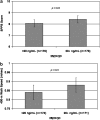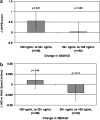Change in 25-hydroxyvitamin D and physical performance in older adults
- PMID: 21325343
- PMCID: PMC3055282
- DOI: 10.1093/gerona/glq235
Change in 25-hydroxyvitamin D and physical performance in older adults
Abstract
Background: Vitamin D deficiency is common among older adults and is associated with poor physical performance; however, studies examining longitudinal changes in 25-hydroxyvitamin D (25[OH]D) and physical performance are lacking. We examined the association between 25(OH)D and physical performance over 12 months in older adults participating in the Lifestyle Interventions and Independence for Elders Pilot (LIFE-P), a multicenter physical activity intervention trial.
Methods: Plasma 25(OH)D and physical performance, assessed by the short physical performance battery (SPPB) and 400-m walk test, were measured at baseline, 6-month, and 12-month follow-up in community-dwelling adults aged 70-89 years at risk for disability (n = 368). Mixed models were used to examine the association between 25(OH)D and physical performance adjusting for demographics, intervention group, season, body mass index, and physical activity.
Results: One half of the participants were vitamin D deficient (25[OH]D < 20 ng/mL) at baseline. In cross-sectional analyses, vitamin D deficiency was associated with lower SPPB scores and slower 400-m walk speeds (mean difference [SE]: 0.35 [0.16], p = .03 and 0.04 [0.02] m/s, p = .01, respectively). Although baseline 25(OH)D status was not significantly associated with change in physical performance over 12 months, individuals who were vitamin D deficient at baseline but no longer deficient at follow-up had significant improvements in SPPB scores (mean difference [SE]: 0.55 [0.22], p = .01) compared with those whose 25(OH)D status remained the same.
Conclusion: Increases in 25(OH)D to greater than or equal to 20 ng/mL were associated with clinically significant improvements in physical performance among older adults.
Trial registration: ClinicalTrials.gov NCT00116194.
Figures



References
-
- Federal Interagency Forum on Aging-Related Statistics. Older Americans 2004: Key Indicators of Well-Being. Washington, DC: U.S. Government Printing Office; 2004.
-
- Guralnik JM, Simonsick EM, Ferrucci L, et al. A short physical performance battery assessing lower extremity function: association with self-reported disability and prediction of mortality and nursing home admission. J Gerontol. 1994;49(2):M85–M94. - PubMed
-
- Newman AB, Simonsick EM, Naydeck BL, et al. Association of long-distance corridor walk performance with mortality, cardiovascular disease, mobility limitation, and disability. JAMA. 2006;295(17):2018–2026. - PubMed
-
- Lips P. Vitamin D deficiency and secondary hyperparathyroidism in the elderly: consequences for bone loss and fractures and therapeutic implications. Endocr Rev. 2001;22(4):477–501. - PubMed

